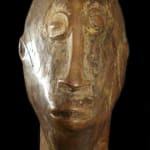Bete Wooden Sculpture of a Man, 1900 CE - 1930 CE
Wood
10.5 x 55.5
PF.4565 (LSO)
Further images
The Bete are a little-studied Ivory Coast group with strong cultural and artistic links to the Dan, the We (Gwere) and the Guro, among others. There are 93 distinct groups...
The Bete are a little-studied Ivory Coast group with strong cultural and artistic links to the Dan, the We (Gwere) and the Guro, among others. There are 93 distinct groups within the Bete polity. They are united only in that they subsistence farm to survive, but base most of their social and cultural lives around the hunt. Social control was exercised by the leading member of individual lineages (of which there were several in each village) who exercised judicial and financial power within the community. Spiritual authority was wielded with an array of paraphernalia, notably including the “gre” mask, a horned and decorated creation (originating with the We) designed to instil terror in the onlooker, to quell social unrest, and to be worn when meting out justice after conflict.
Statuary is rare, and is based around feminine iconography that refers to the mythical mother figure. There is no recognised liturgical function, although some early reports indicate that a pair of figures was often placed under a rain shelter in a village in order to represent the founders. This evocation of a primeval couple has widespread resonance in African culture. Male figures, however, are vanishingly rare in Western collections.
The current example is exceptional. Standing tall on slightly flexed knees, the stance is one of immovable massivity. The torso is long and lean, leading to a powerfully built and anteroposteriorly deep chest. The arms lie rigidly alongside the body, the hands level with the waist. The neck is elongated, and displays an Adams Apple: it supports a dynamically modelled head that is mediolaterally compressed and anteroposteriorly elongated. The eyes are protuberant and are slightly reminiscent of the Dogon format, the nose formed as an inverted “T” over a small, slightly-pursed mouth. The hands and feet are solid and massive, the ankles bound with metal anklets.
The notable virility of the figure is remarkable in that exposed genitalia are usually construed as a threat in African society, especially if exaggerated in this manner. The realism, especially when compared to the rest of the figure, also seems to suggest that this particular area of the statue had some deeper significance. It might be that the figure is meant to represent fertility, which would be appropriate in light of the Bete’s sentiment regarding maternity. It may have been an idol from which women unable to conceive would request supernatural assistance. Alternatively, it may have constituted a more general role, evoking or celebrating the fertility of the village/land, its founders, or the forest from which the people made their living.
The outstanding glossy patina, highlighted with traces of kaolin, seems to argue against exposure to the elements as has been described by early explorers. It is more likely that this figure stood in a central and presumably magico-religiously important site within the village, where it performed some valuable social function that was probably linked with fertility. This is an outstanding and extremely rare masterpiece of African art.
Statuary is rare, and is based around feminine iconography that refers to the mythical mother figure. There is no recognised liturgical function, although some early reports indicate that a pair of figures was often placed under a rain shelter in a village in order to represent the founders. This evocation of a primeval couple has widespread resonance in African culture. Male figures, however, are vanishingly rare in Western collections.
The current example is exceptional. Standing tall on slightly flexed knees, the stance is one of immovable massivity. The torso is long and lean, leading to a powerfully built and anteroposteriorly deep chest. The arms lie rigidly alongside the body, the hands level with the waist. The neck is elongated, and displays an Adams Apple: it supports a dynamically modelled head that is mediolaterally compressed and anteroposteriorly elongated. The eyes are protuberant and are slightly reminiscent of the Dogon format, the nose formed as an inverted “T” over a small, slightly-pursed mouth. The hands and feet are solid and massive, the ankles bound with metal anklets.
The notable virility of the figure is remarkable in that exposed genitalia are usually construed as a threat in African society, especially if exaggerated in this manner. The realism, especially when compared to the rest of the figure, also seems to suggest that this particular area of the statue had some deeper significance. It might be that the figure is meant to represent fertility, which would be appropriate in light of the Bete’s sentiment regarding maternity. It may have been an idol from which women unable to conceive would request supernatural assistance. Alternatively, it may have constituted a more general role, evoking or celebrating the fertility of the village/land, its founders, or the forest from which the people made their living.
The outstanding glossy patina, highlighted with traces of kaolin, seems to argue against exposure to the elements as has been described by early explorers. It is more likely that this figure stood in a central and presumably magico-religiously important site within the village, where it performed some valuable social function that was probably linked with fertility. This is an outstanding and extremely rare masterpiece of African art.
Literature
V24









